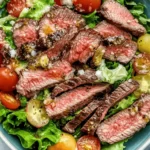The Lebanese Fattoush Salad is a vibrant dish bursting with garden-fresh vegetables, herbs, and golden pita chips, tossed in a bright, citrusy sumac dressing. Each bite delivers a refreshing mix of textures—crunchy, juicy, and zesty—making it a feast for both the eyes and palate.
Perfect as a side dish or a light main course, Fattoush is rooted in Levantine tradition and adaptable for modern kitchens. This wholesome salad brings the essence of Lebanese home cooking to your table with simplicity, flavor, and nutrition all in one bowl.
Full Recipe:
-
2 pieces pita bread
-
1 tablespoon olive oil
-
Salt to taste
-
1 head romaine lettuce, chopped
-
2 medium tomatoes, diced
-
1 cucumber, diced
-
1 green bell pepper, diced
-
4 radishes, thinly sliced
-
2 green onions, sliced
-
1/4 cup fresh parsley, chopped
Dressing:
-
1/4 cup extra virgin olive oil
-
Juice of 1 lemon
-
1 tablespoon ground sumac
-
1 clove garlic, minced (optional)
-
Salt and pepper to taste
Directions:
-
Preheat oven to 375°F (190°C).
-
Cut pita bread into 1-inch pieces. Toss with olive oil and salt. Spread on a baking sheet and bake for 5–7 minutes until golden and crispy.
-
Chop lettuce, tomatoes, cucumber, bell pepper, radishes, green onions, and parsley. Combine in a large salad bowl.
-
In a small bowl, whisk together olive oil, lemon juice, sumac, garlic (if using), salt, and pepper to make the dressing.
-
Pour dressing over the vegetables and toss well.
-
Just before serving, add crispy pita pieces and toss lightly again.
-
Serve immediately and enjoy fresh.
Prep Time: 15 minutes | Cooking Time: 7 minutes | Total Time: 22 minutes
Kcal: 210 kcal | Servings: 4 servings
What is Lebanese Fattoush?
Fattoush is a staple in Lebanese and Levantine cuisine, celebrated for its fresh ingredients, vibrant presentation, and tangy flavor profile. At its core, it’s a chopped vegetable salad tossed with crispy pieces of toasted or fried pita bread and a lemony sumac dressing. The name “Fattoush” comes from the Arabic word “fatteh,” which means “crumbs,” referencing the pita bread traditionally used in the dish.
This salad isn’t just a side—it’s a cultural touchstone. Often served at large gatherings, mezze spreads, and family dinners, Fattoush holds a significant place in Middle Eastern culinary tradition. It showcases the region’s deep appreciation for seasonal produce, zesty flavors, and resourcefulness—transforming day-old pita bread into an irresistible, crunchy highlight.
Cultural Significance of Fattoush
Fattoush is more than just a dish; it’s a symbol of Levantine hospitality and sustainability. Historically, families in Lebanon, Syria, and Palestine would use leftover pita bread to create a fresh salad for their meals, reducing waste and adding a unique texture. This dish reflects the “nothing wasted” philosophy that has been passed down through generations in Middle Eastern households.
Traditionally served as part of a mezze—an assortment of small dishes meant for sharing—Fattoush is designed to be enjoyed communally. Its role in festive gatherings, Ramadan iftars, and summer lunches has made it a beloved classic. The salad is also found in various regional adaptations, with different families incorporating their own herb blends, dressings, and vegetables depending on what’s in season or locally available.
The Role of Sumac in Fattoush
One ingredient that truly sets Fattoush apart is sumac, a deep red spice with a tangy, lemon-like flavor. It’s made by drying and grinding the berries of the sumac bush, native to the Middle East. In Fattoush, sumac provides the signature sour kick that balances the freshness of the vegetables and the richness of the olive oil.
Sumac is also known for its antioxidant properties and has been used for centuries in Middle Eastern and Mediterranean medicine and cuisine. In this salad, it’s typically mixed into the dressing or sprinkled over the top, lending both color and flavor to the final dish.
The Magic of Toasted Pita
What makes Fattoush especially satisfying is the contrast between crisp pita bread and fresh vegetables. The pita is usually cut into bite-sized pieces, tossed with olive oil and salt, and either baked, pan-fried, or deep-fried until golden. This technique transforms plain bread into crunchy crouton-like bites that absorb the dressing slightly without becoming soggy.
Some cooks opt for an air fryer as a modern, healthier method, while others stick to traditional deep-frying for the ultimate crunch. Either way, the pita adds heartiness and texture that elevates Fattoush beyond a typical salad.
Flavor Profile and Texture
The brilliance of Fattoush lies in its harmony of flavors and textures. It’s crunchy, juicy, tangy, and herbaceous all at once. You get the coolness of cucumbers, the slight spice of radishes, the juiciness of tomatoes, and the brightness of fresh herbs like parsley and sometimes mint.
The dressing—made with lemon juice, extra virgin olive oil, garlic, and sumac—is simple but incredibly bold. It coats every vegetable in just enough tang and richness without overpowering the freshness of the produce.
The salad can easily be adapted to suit personal preferences. Some versions include pomegranate molasses for sweetness or crumbled feta cheese for creaminess. Others mix in arugula, spinach, or carrots to create even more variation in taste and nutrition.
Health Benefits of Fattoush
Fattoush is not only delicious but also highly nutritious. It’s naturally low in calories and rich in fiber, vitamins, and antioxidants. Here are some of the health benefits it offers:
-
Rich in Fiber: Thanks to the variety of vegetables and the inclusion of whole wheat pita, Fattoush supports digestive health and keeps you feeling full longer.
-
High in Antioxidants: Ingredients like sumac, tomatoes, cucumbers, and olive oil provide essential antioxidants that help combat inflammation and oxidative stress.
-
Heart-Healthy: The use of extra virgin olive oil offers monounsaturated fats that support cardiovascular wellness.
-
Hydrating: With high-water content vegetables like cucumbers and lettuce, Fattoush is excellent for hydration, especially in warm climates or seasons.
-
Customizable for Dietary Needs: Fattoush is naturally vegetarian and can easily be made vegan. Gluten-free pita or chips can be used to accommodate gluten intolerance.
Perfect Pairings and Serving Ideas
Fattoush is incredibly versatile and can be enjoyed in multiple ways. It’s commonly served as an appetizer or side dish, but it’s hearty enough to stand alone as a light meal. Here are some favorite pairings:
-
Grilled Meats: Serve alongside grilled chicken, lamb skewers, or kebabs for a complete Middle Eastern meal.
-
Hummus and Falafel: Add to a mezze platter with hummus, baba ghanoush, and falafel.
-
Stuffed Pita Wraps: Stuff into a pita with grilled halloumi or leftover roast vegetables for a tasty wrap.
-
Seafood: The citrusy notes of Fattoush make it an excellent companion to grilled fish or shrimp.
-
Lentil Soup: Pair with a warm bowl of lentil or vegetable soup for a nourishing lunch or dinner combo.
Fattoush is also a hit at potlucks, picnics, and barbecues due to its vibrant colors and refreshing taste. When prepping in advance, keep the dressing and pita separate until right before serving to maintain the salad’s crisp texture.
How Fattoush Differs from Tabbouleh
While both are iconic Lebanese salads, Fattoush and Tabbouleh are quite different. Tabbouleh is parsley-forward, featuring finely chopped parsley, mint, tomatoes, bulgur, and lemon juice. It has a finer, more herb-dense texture and is often eaten in smaller quantities as a garnish or condiment.
Fattoush, on the other hand, is more of a garden salad with a wide variety of vegetables and a hearty crunch from the pita chips. The two often appear side by side in mezze spreads, each offering its own distinct flavor and style.
Global Popularity and Modern Adaptations
Fattoush has crossed borders and become a favorite in international kitchens due to its easy preparation and universal appeal. Health-conscious foodies and salad lovers appreciate its freshness, while chefs enjoy how easily it can be customized and elevated.
Modern takes include adding avocado, roasted chickpeas, or even grilled fruit. Some versions fuse global elements—like using naan or tortilla chips instead of pita or incorporating non-traditional herbs like basil. These adaptations keep the dish dynamic and appealing to diverse palates.
Despite its adaptability, the heart of Fattoush remains the same: a celebration of freshness, balance, and the beauty of simple ingredients.
Conclusion
Lebanese Fattoush salad is a testament to how humble ingredients can be transformed into a dish bursting with life and flavor. Rooted in tradition but endlessly adaptable, Fattoush embodies the best of Middle Eastern cuisine—fresh, vibrant, healthy, and communal.
Whether you’re enjoying it as part of a lavish mezze or making a quick weekday salad, Fattoush offers an experience that is satisfying and wholesome. Its delightful combination of crispy, juicy, tangy, and savory elements ensures it will remain a timeless favorite for generations to come.
Incorporating Fattoush into your culinary repertoire means embracing the spirit of the Levant, where food brings people together, celebrates nature’s bounty, and nourishes both body and soul.





